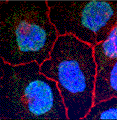Biochemistry, Department of
Document Type
Article
Date of this Version
1990
Abstract
Evidence is presented for the operation in nodules of at least four systems for restoring functional ferrous leghemoglobin (Lb2+) from its inactive, ferric form. (i) Reduction of ferric leghemoglobin (Lb3+) by a reductase. The enzyme is a flavoprotein of 100 kDa with two equally sized subunits and exhibits a Km of 9 µM for soybean Lb3+ component a and a K. of 51 µM for NADH. NADPH is only 30% (initial velocities) as effective as NADH. Lb3+ reductase converts 215 nmol of Lb3+to Lb2+ •CO (or Lb2+ •O2) per mg of protein per min and does not require an exogenous electron carrier. The enzyme shows similar affinity for soybean, bean, and cowpea Lb3+, but different Vmax values. The reductase is inactive when Lb3+ is bound to nicotinate or N02 ˉ. (ii) Direct reduction of Lb3+ by NAD(P)H, ascorbate, and cysteine. Reduction by NAD(P)H is greatly stimulated by trace amounts of metals such as Mn2+. (iii) Reduction of Lb3+ by the flow of electrons from NAD(P)H to free flavins to Lb3+. The reaction does not occur via 02ˉ or H202, and thus NAD(P)H-reduced flavins can directly reduce Lb3+. The efficiency of the reaction follows the order riboflavin > FMN > FAD. (iv) Reduction of Lb3+ by an unknown compound, B, of nodules. B has a molecular mass < 1 kDa and is heat-stable. The reaction mediated by B differs from those mediated by flavins and metals in several ways, requires NAD(P)H, and generates 02ˉ.



Comments
Published in Proc. Natl. Acad. Sci. USA Vol. 87, pp. 7295-7299, September 1990